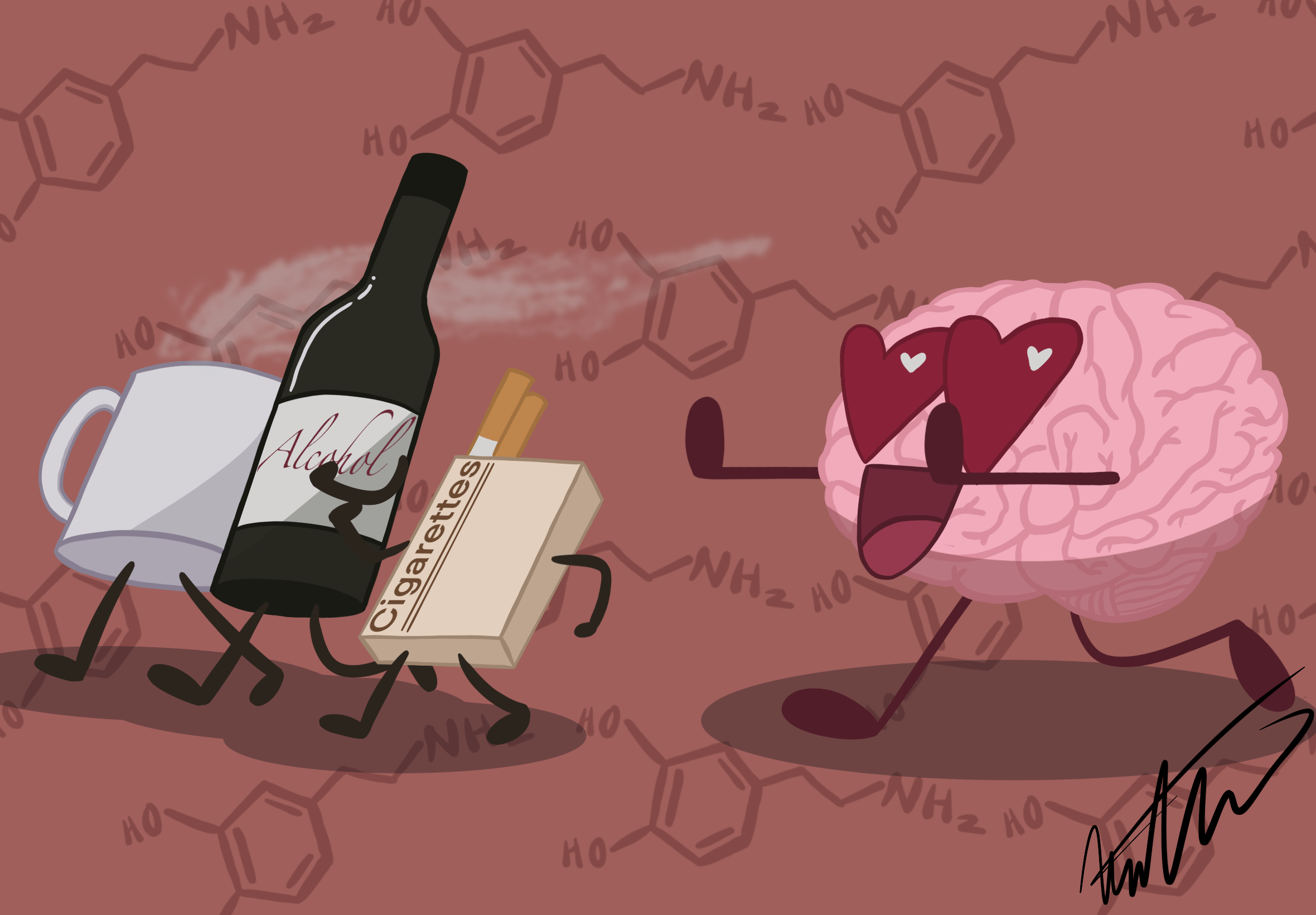How Dopamine Plays a Role in Addiction
And not just in relation to drugs and alcohol.
Written by: Laura Schusser | Edited by: Sanjna Sunil | Graphic by: Nalani Wooton
Drugs, alcohol, sex. Words like these often come to mind when we think of addiction, but addiction can also take root in socially praised habits, like work, fitness, or even wellness itself. However, what makes addiction different? Its escalating and compulsive nature. The behavior becomes difficult to control, even when it leads to harm, and breaking the cycle requires more than just willpower. Over time, the brain’s reward circuitry adapts, making natural rewards feel dull and leaving the individual increasingly dependent on the addictive stimulus for a sense of pleasure, relief, or escape. There are genetic, environmental, and developmental underpinnings to addiction science. The precise neurophysiological mechanisms are still being explored by researchers, but a major area of research is dopamine.
Dopamine is a neurotransmitter or chemical messenger in the brain commonly associated with pleasure. It is mainly produced in the two regions called the substantial nigra (SNc) and ventral tegmental area (VTA). These nuclei exist in the midbrain of our brainstem. You can imagine the midbrain as the top part of a tree trunk, right before it breaks out into the leaves. The leaves are our cerebrum, where our emotion-regulation and high-order processing centers sit. The top part of the tree trunk is responsible for delivering nutrients and minerals to the leaves on the upper branches, allowing them to grow and photosynthesise. This is much like how the midbrain relays information to the cerebrum.
Neurotransmitters act as the nutrients, fed from the midbrain to the cerebrum to inflict motivation and reward-related effects. The "nutrient flow" allows midbrain structures like the SNr and VTA to influence higher-order brain regions.
Once produced, dopamine travels via four major pathways.
Nigrostriatal pathway: originates at the substantia nigra (remember that top portion of the tree trunk) and targets the dorsal striatum. The dorsal striatum is an area of the inner brain responsible for filtering your movements.
Mesolimbic pathway: originates at the other dopamine manufacturing center, the VTA. It targets the ventral striatum and plays a role in reward, motivation, and reinforcement learning.
Mesocortical pathway: starts in the VTA and travels to the limbic cortex. It functions to control our attention and emotional responses.
Tuberoinfundibular pathway: acts on our hypothalamus, another brain region that regulates basic bodily functions. The pathway is part of the limbic system too, but is tucked deeper inside the brain.
In addiction, the mesolimbic and mesocortical dopamine pathways are most affected. Drugs or addictive behaviors cause an excessive dopamine release from the VTA to the ventral striatum, creating strong feelings of pleasure and reward. Over time, this floods the brain’s reward system, weakening natural dopamine responses and making normal activities feel less rewarding. Impairment to the mesocortical pathway (to the prefrontal cortex) also reduces impulse control and decision-making.
When functioning properly, the dopamine pathways are a normal and healthy part of daily life. You may experience dopamine rushes when you are hanging out with friends, receiving a gift, or completing an empowering workout. Danger arises when dopamine becomes excessive, causing the brain to rely heavily on pleasurable sensations for motivation or emotional regulation. Such dysregulation is common with artificial substances like drugs, but can also occur with behaviors that are socially encouraged,such as work, fitness, or even health optimization.
These articles are not intended to serve as medical advice. If you have specific medical concerns, please reach out to your provider.

